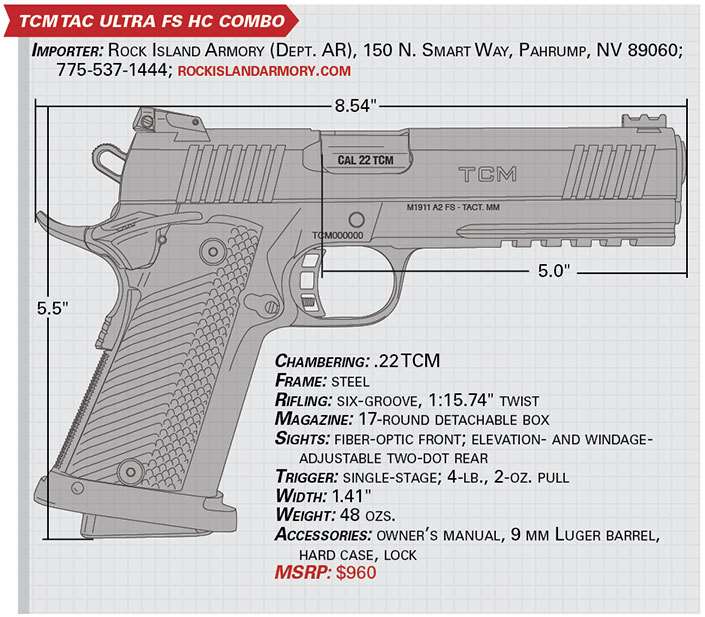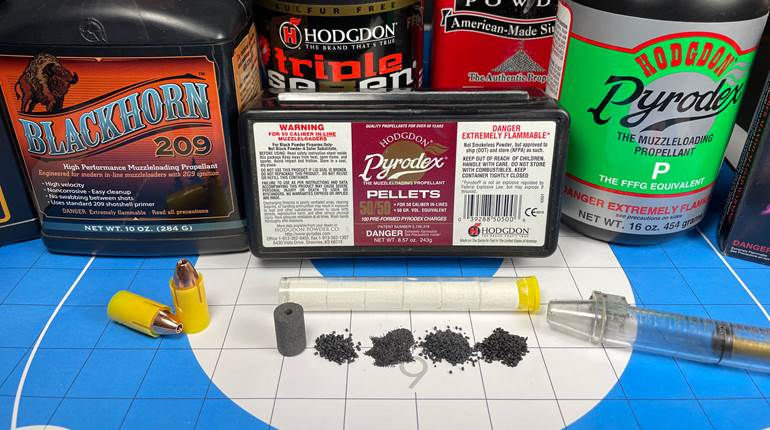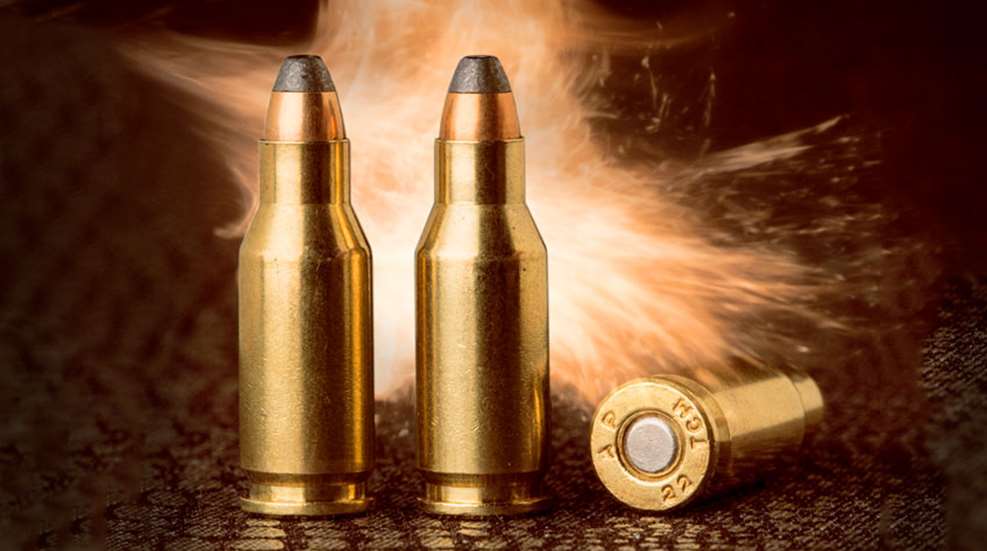
Cartridge wildcatters are visionaries. For them, an existing cartridge is simply a stick of moldable clay or an unchiseled block of marble hiding a masterpiece within. Adhering to an avant-garde approach, wildcatters such as Charles Newton, P.O. Ackley, Ned H. Roberts, Richard J. “Dick” Casull, Ken Waters and J.D. Jones, among many others, altered existing cartridges (or created new ones) in order to improve efficiency, increase velocity, maximize energy, better consistency or, in certain cases, fulfill a niche. For gunsmith and Armscor/Rock Island Armory (RIA) consultant Fred Craig, the latter was the impetus for creating the .22 TCM.
In developing the cartridge which was originally coined .22 Micromagnum, Craig sought to produce an affordable, high-performance, .22-cal. center-fire cartridge suitable for use in the ubiquitous M1911 platform. It’s widely reported that, while Craig was working at Armscor’s Marikina, Philippines, facility, company president Martin Tuason became enamored with the cartridge and the prospects of chambering it in the company’s guns. Craig’s wildcat was then renamed .22 TCM, for Tuason-Craig-Micromagnum, and, shortly thereafter, production of .22 TCM M1911 pistols began.
Wildcatting
In true wildcatter style, Craig eschewed existing pistol cartridges for the parent case; they were incapable of providing the inspiring external ballistics that he pursued. Testing revealed that such was true of the .30 Carbine, too. Craig found the perfect parent case to be the ubiquitous .223 Rem. Why?
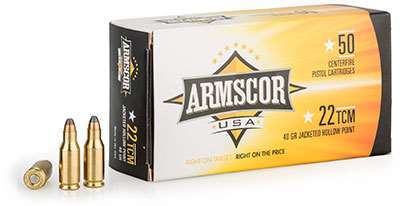
Key to the development of the .22 TCM was functionality through 9 mm Luger magazines. That requirement mandated that some critical dimensions of the new case—such as rim diameter and body width—be reasonably close to those of the 9 mm Luger cartridge. The .223 Rem. case was suitable for the task because, according to Sporting Arms and Ammunition Manufacturer’s Institute (SAAMI) specifications, the 9 mm Luger/Luger +P have a rim diameter measuring 0.394" (-0.010"), while the .223 Rem. is 0.378" (-0.010"). Sample Armscor .22 TCM loads measured 0.374" across the rim. Moreover, the diameter at the case mouth of the 9 mm Luger and the shoulder of the .22 TCM are, once again, close enough for sure functioning in magazines designed for the 9 mm Luger.
With a maximum average pressure (M.A.P.) of 55,000 p.s.i., the .223 Rem. case is also robust—especially in the critical web area. Achieving 2000 f.p.s. with a 40-gr., 0.224"-diameter, jacketed-hollow-point bullet from a 5"-barreled M1911 pistol is no easy feat; in fact, factory ammunition is currently loaded to around 40,000 p.s.i. That’s higher than the M.A.P. of the 9 mm Luger +P (38,500 p.s.i.), .38 Super Auto +P (36,500 p.s.i) and 10 mm Auto (37,500 p.s.i.). Its pressure mimics the M.A.P. of the .357 Rem. Max. Keep in mind that the .22 TCM isn’t a SAAMI-approved cartridge yet, so no “standards,” such as a M.A.P., currently exist for it.
Given its case length of 1.760" (-0.020"), the .223 Rem. required significant shortening to function in an M1911. The .22 TCM’s case is 1.025" long, and the maximum cartridge overall length (C.O.L.) is 1.265" (some sources cite this as 1.260")—0.010" less than that of the .45 ACP—though measured factory loads ranged from 1.241" to 1.250". In comparison, the 9 mm Luger’s C.O.L. is 1.169". Giving the cartridge its rifle-like bottleneck shape is a body with very minimal taper and a somewhat sharp shoulder angle. Further, whereas the rim on the .223 Rem. is 0.045" (-0.010") thick, that on the .22 TCM measures 0.050"—identical to the 9 mm Luger (0.050"-0.010"). Lastly, to improve functioning in M1911s the .22 TCM’s extractor groove has been altered; it more closely approximates that of the 9 mm Luger than its .223 Rem. parent. A small pistol primer provides ignition.
Factory ammunition for the .22 TCM is limited to that produced by Armscor, and the company’s website currently lists only a single projectile—a stubby, 0.469"-long proprietary, jacketed hollow point with simple cup-and-core construction. Featuring a wide, flat meplat and a significant amount of exposed lead, it’s ideal for “soft” targets such as varmints and predators—especially at the high velocities that the cartridge can propel it.
The bullet’s blunted profile can be considered a “catch-22”; necessary to preserve its modest overall length for sure functioning from 9 mm Luger magazines, the semi-spitzer design—especially when combined with a flat base—lessens the ballistic coefficient, or the projectile’s aerodynamic qualities. It’s a moot point at typical M1911 ranges, but it becomes a real consideration when the cartridge is employed in the M22 TCM BA bolt-action rifle for hunting. Essentially, it relegates the round to mid-range varminting, a realm also occupied by the .17 WSM, .22 Hornet, 5.7x28 mm FN and .218 Bee. As for cost, 50-count boxes of Armscor .22 TCM 40-gr. JHP ammunition sell for as low as $16.45 (outdoorlimited.com). At that price, it certainly bests the price of the other .22-cal., mid-range center-fire rounds.
Given the limited selection of factory ammunition from which to choose, you’re likely to contemplate handloading. Again, not being a SAAMI-approved cartridge complicates things. Although dies are readily available from Hornady, Redding and Lee, as are component brass and bullets from Armscor, data from reputable sources isn’t. Be forewarned: the majority of data available online is assembled by hobbyists, not experts. Until the cartridge receives SAAMI acceptance, don’t expect to find .22 TCM reloading data from most propellant and bullet manufacturers. Such is one downside to owning a wildcat and/or proprietary cartridge.
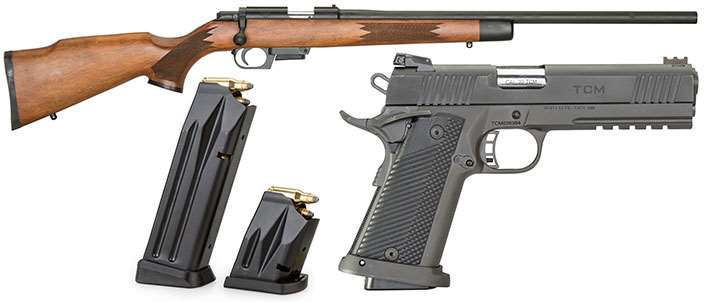
Why?
Although Craig envisioned a .22-cal. handgun cartridge offering high performance and minimal cost, as is often the case, secondary uses emerged. As a handgun cartridge, the .22 TCM affords the M1911 aficionado a low-cost, minimal-recoil experience with which to hone marksmanship and personal-protection skills. This is especially important for novices and those who are recoil-shy. It could serve as a convenient sidearm companion on backcountry forays, and would be well-suited for dispatching pasture-prowling nuisance critters when checking livestock.
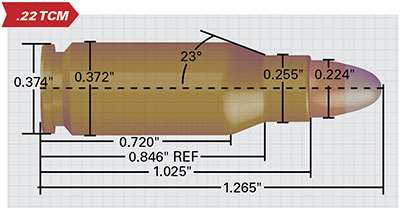
Is the .22 TCM a self-defense round? According to Armscor’s website, the uses of its .22 TCM ammunition are: “Target Practice, Plinking Firearms.” Can it be employed for personal protection, though? There are many videos online showing the cartridge’s 40-gr. JHP bullet impacting ballistic gelatin, and the results are impressive—much better than the terminal performance imparted by .22-cal. rimfires. However, there’s no denying the advantages gained by using a traditional, defensive caliber loaded with heavier projectiles specifically designed for protection. Ultimately, it’s the buyer’s decision. For ease of convenience, you can purchase a Rock Island Armory M1911 combination package that comes with both a .22 TCM and a drop-in 9 mm Luger accessory barrel.
One of the best features of the .22 TCM cartridge is its ability to be used in both a handgun and a rifle. Therefore, the owner of a TCM M1911 pistol who also has a M22 TCM BA rifle could use ammunition interchangeably. Additionally, the aforementioned longarm can use the same 17-round-capacity, double-stack magazine as the HC versions of the TCM M1911s. Talk about convenience!
The increased velocity from the 22” barrel of the M22 TCM BA will endear it to varmint hunters in areas where shots are limited to 200 yds. or less. Beyond that distance, it’s time for a .223 Rem. Used within its effective range, the .22 TCM is adequate for coyote and ideal for groundhog. Although its been employed for hog control/hunting, it’s marginal for all but perfect shots. There are many better options for the task.
Fire Breather
For accuracy and function testing, as well as chronographing, Armscor sent me a TCM TAC Ultra FS HC Combo M1911 pistol and a complementary, un-scoped M22 TCM BA rifle ($454 MSRP). Concerning the latter, as it has a simple integrated rimfire-style 3/8" optic rail, I installed a Simmons Master Series Prodiamond 1.5-5X 32 mm scope in Weaver Tip-Off rings. The same 40-gr. JHP .22 TCM load was fired in both firearms.
Firing from a bench at 25 yds., the TCM TAC Ultra FS HC recorded an average of 2.77" for five consecutive, five-shot groups. The best group measured 2.50", while the largest went 3.03". According to a Competition Electronics chronograph, which was placed 10 ft. from the muzzle, the bullet attained 2066 f.p.s. from the 5" muzzle. The recorded standard deviation was 18. Muzzle energy was 379 ft.-lbs.
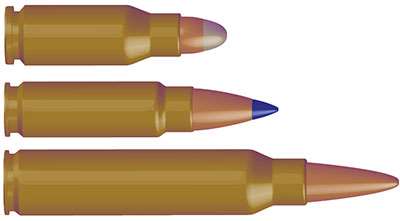
As is emphasized on the company’s website—i.e. “performs like a flamethrower”—the muzzle signature (and attendant blast) produced in the M1911 by the .22 TCM is impressive; forget preserving one’s night vision in low-light conditions. I recommend doubling up on hearing protection. In the heavy—3 lbs., unloaded—competition-style pistol, recoil was nil, which enabled an extended shooting session and rapid follow-up shots. There were no malfunctions in more than 100 rounds of firing. Just as a word of caution, at typical self-defense distances the .22 TCM and 9 mm Luger (in their respective barrels) grouped closely; however, at 25 yds. impacts from the latter were about 2" to 4" above the highest hits of the .22 TCM—sight adjustment might be necessary.
Testing of the .22 TCM in the M22 TCM BA commenced from a bench at 100 yds. As can be expected, when fired from the 22" barrel of the M22, the .22 TCM makes tremendous gains in velocity; in fact, it averaged 2752 f.p.s. for 10 consecutive shots. Muzzle energy was 673 ft.-lbs., and standard deviation was 23.
Shooting for accuracy, the M22 averaged 1.95" for five consecutive, five-shot groups at 100 yds. The tightest group measured a very respectable 1.15", while the largest went 2.40". For varmint hunting at the cartridge’s maximum practical ranges, such accuracy is sufficient. In a rifle in which the cartridge isn’t limited by the constraints of a pistol magazine, and where streamlined, polymer-tipped projectiles could be used, the cartridge would really shine.
It must be noted that, though the M22 fed fine, extraction was difficult and ejection was inconsistent. With the provided five-round magazine in place, ejection was impossible; in fact, after each shot the magazine had to be removed for the case to be expelled. When employing the 17-round HC version from the Tac Ultra, ejection was far more reliable, though still not perfect. It’s my hope that SAAMI approval is attained and other arms makers bring to market .22 TCM-chambered rifles, as the cartridge’s full potential in a long gun isn’t currently being realized.
Gone are Newton, Ackley, Roberts, and others, but, as Fred Craig has demonstrated, the wildcatting spirit continues. Long live the visionaries!
